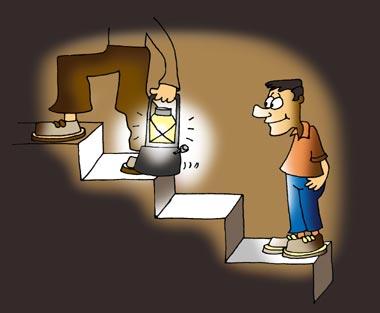 | « Back to article | Print this article |
11 lessons from cricket to help you ace the CAT this year
When we talk of preparing for MBA entrance exams, we normally think of areas such as verbal ability, mathematics, reasoning, data interpretation, mock tests etc.
The only time, "unimportant" topics such as sports or cricket enter the discussion is when we think of general knowledge and current affairs for exams such as the IIFT (Indian Institute of Foreign Trade), SNAP (Symbiosis National Aptitude Test) and CMAT (Common Management Admission Test).
However, what most aspirants don't realise is that is there is a very strong co-relation between the way you prepare for an MBA entrance exam and the way you follow or play any sport.
Since cricket is a religion for most Indians, let us look at just 11 learnings taken from cricket and how they can be used while preparing for an MBA entrance exam.
Please click NEXT to continue reading...
Courtesy:11 lessons from cricket to help you ace the CAT this year
Cricket Tip # 1: Know what shots (or balls) suit you the best and master them as much as you can!
The most successful cricketers are not those who are able to play all the shots in the book or bowl all kinds of deliveries, but those who are able to identify the shots or balls that they can get the maximum benefit from or rely on when in trouble.
Most cricketers have a "go-to shot" or stock ball" that they use and depend on when they want to get out of a sticky situation.
MBA Tip #1: Identify the chapters (and question types) that you are most comfortable with and maximise your score in those questions types.
Like every cricketer, each one of you will have certain chapters that you are very comfortable with and where you can maximise your score.
Identify five to six chapters in each section where you are strong and use them to get your best possible score.
Illustration: Uttam Ghosh
11 lessons from cricket to help you ace the CAT this year
Cricket Tip #2: The best cricketers never rely on one shot/ball and when that fails, they temporarily cut it out from their armoury!
The "pasha of spin" Shane Warne never relied only on the conventional leg spinner to get batsmen out.
He also had back-up deliveries such as the "flipper", the "googly" and the "zooter" to fall back on when the leg-break was not working. This simply illustrates the importance of back-ups while playing the game!
Most cricket fans would remember a Sachin Tendulkar double century in Sydney where he completely cut out the cover drive because he was repeatedly getting out to that shot.
Everyone knows that he can play that shot as well as anyone else. However, even the best sometimes acknowledge that a certain strength is failing them and so don't use it for some time.
MBA Tip #2: Even when you have identified your strengths, have back-ups for each section and be prepared to NOT solve questions from your favourite area if you are going wrong there!
Let us assume that you have identified geometry as a strong area in the exam.
However, it is absolutely important to have a second strength as a back-up to avoid a scenario where you are stuck-up simply because there are no geometry questions in your CAT slot! This applies to all sections in all entrance exams.
Also, please keep in mind that even in areas where you are generally good, you may keep going wrong in two or three consecutive mocks.
If that happens, you may need to avoid attempting questions from that area for the time being. In fact, this is also a critical reason why you should have ample chapters ready as back-up.
Illustration: Dominic Xavier
11 lessons from cricket to help you ace the CAT this year
Cricket Tip #3: Learn to bowl a particular ball in multiple ways to gain the most from it!
How many times have we seen Lasith Malinga bowl a slower yorker AND a faster yorker in the same over and get wickets of both deliveries?
How many times have you seen Brett Lee bowl a bouncer at the throat, chest and a slower bouncer as well to get wickets?
Even when a bowler has a stock ball, s/he has to develop variations of this delivery to keep herself/himself ahead of the curve!
For bowlers who don't learn this lesson, look up the case of Paul Adams!!
MBA Tip #3: Learn to practise your strong and medium areas in different ways, rather than sticking to one approach.
With practice, you may become good or excellent at solving questions on numbers or complex arrangements or jumbled sentences, but NEVER stop at that stage.
Make it a point to try and solve the same problems in different ways that use some other approach such as substitution of values, elimination of answer options etc. This will ensure that you solve questions faster in the exam and are better prepared in case a certain variant of a problem type is asked and you are unable to solve it using the conventional approach!
Even if this does not work, you have your regular method to fall back on!
Illustration: Uttam Ghosh
11 lessons from cricket to help you ace the CAT this year
Cricket Tip #4: First learn to bowl a particular ball in its most standard way and then try its variants!
This tip is a direct corollary of the previous tip.
Lasith Malinga first learnt the yorker by aiming at a single shoe at the same spot for years before he started practising the other variants of the same ball such as the slower yorker or the yorker outside the off stump.
Had he not learnt how to bowl the conventional yorker, he would not have been able to manage the variations as well.
MBA Tip #4: Learn the basics of a chapter/question type first and then use the shortcuts/tips etc.
Again, following from the previous point, you should not try to solve questions on numbers or comprehension using various shortcuts that you have learnt till you are completely comfortable with the basic concepts and solving methods for these questions.
While the shortcuts may seem glamorous or tempting, they could be fatal if the question has a "trap" that people with a lack of fundamentals may miss.
Illustration: Dominic Xavier
11 lessons from cricket to help you ace the CAT this year
Cricket Tip #5: Each shot needs to be played in slightly different ways depending on the pitch and ground!
On Sachin Tendulkar's first tour to England and Australia, Sunil Gavaskar explained him the minor differences in the nature of the pitches in both countries and how the square cut was to be played accordingly.
So, while the techniques of the shot remained the same, it was to be executed differently on different grounds!
MBA Tip #5: Each question type may be asked in different ways in different exams! So, practice accordingly!
Have you observed the way an RC set/question is asked in the CAT, CMAT, IIFT and XAT?
While the CMAT has very small sets with single questions and the IIFT has very long sets with data driven questions, the CAT and XAT have moderately long sets with primarily inferential questions.
While the basic techniques to solve an RC remain the same across exams, you need to keep these minor variations in mind while practising questions for each exam.
This same approach applies to QA, LR and VA questions as well!
Illustration: Uttam Ghosh
11 lessons from cricket to help you ace the CAT this year
Cricket Tip #6: The best cricketers set challenges for themselves to keep improving all the time!
Jonty Rhodes was once asked how he managed to be such an excellent fielder.
His response was that he used to set targets for himself that he would not let any ball within a few feet on either side to pass him for certain number of overs.
He then strived to achieve that. Sachin Tendulkar and Javagal Srinath used to have a special over in net sessions where Srinath would try to concede the least runs and Tendulkar would try to gain the most.
They used this as practice for slog overs! These challenges help great cricketers become better!
MBA Tip #6: Challenge yourself on various areas and observe your progress continuously!
Rather than blindly practising 50 to 100 questions every day, set challenges on a day-to-day basis and try to achieve them.
So, one day, you could be trying to solve five complex arrangement sets in one hour with 90 per cent accuracy and the next day, you could be trying to solve critical reasoning questions with a 80 per cent accuracy without a time limit.
Set different challenges every day. This will keep you motivated and allow you to become better in all areas of your MBA preparation.
Illustration: Dominic Xavier
11 lessons from cricket to help you ace the CAT this year
Cricket Tip #7: Plan how you will approach each game and be ready to adapt!
If you have observed Jacques Kallis or Sachin Tendulkar bat in ODI (One Day International) games in their pomp, you would have noticed that they would defend against bowlers such as McGrath or Akram and attack the others in the bowling attack.
They have explicitly mentioned in interviews that their objective was to score runs over the course of the entire innings and NOT inflate their egos by attacking the most dangerous bowler.
However, keep in mind that if the occasion demanded, they would definitely do that as well!
MBA Tip #7: Plan how you will attempt the entire exam and then be ready to adapt depending on the difficulty level of each section!
In an exam like the SNAP, keep in mind that the LR section gives you the most marks while being easy. So, this is the section that you should attack while not falling prey to the most difficult one i.e. GK.
If your objective is to maximise your marks in the SNAP, you should NOT fall into the trap of satisfying your ego by trying to crack the entire GK section.
However, if LR is tough, you may need to gain those extra marks from everywhere else, including GK. This logic applies to each and every exam!
Illustration: Dominic Xavier
11 lessons from cricket to help you ace the CAT this year
Cricket Tip #8: Batsmen see how they get out and try not to repeat those mistakes!
Every top class batsman, bowler and fielder video-analyses each and every game to see where he is doing well, where he is going wrong and so on.
Also, they don't just see this analysis at the overall level but break it down in terms of how they batted in different stages of the innings or how they bowled on both sides of the wicket and so on. It is this continuous analysis that helps them become better cricketers!
MBA Tip #8: Analyse your performance after each test and avoid repeating mistakes!
This has been said in various places by various people and is probably THE MOST IMPORTANT thing to do when you prepare.
If you keep on doing the same things again and again, you will never become excellent at cracking the entrance exams.
You have to identify your best and worst areas and keep analysing them from the broadest level (i.e. overall exam) to the narrowest (i.e. question type). The better and more comprehensive your analysis, the better are your chances of doing well in the actual exam!
Illustration: Dominic Xavier
11 lessons from cricket to help you ace the CAT this year
Cricket Tip #9: Modern day cricketers have to be good at at least two out of three skills -- batting, bowling and fielding!
Gone are the days when you could be a class batsmen, non-bowler and pathetic fielder and still get selected in international teams.
Today, you see a Harbhajan Singh or Stuart Broad contributing handy lower-order runs as a secondary skill or an A B Devilliers becoming the wicketkeeper apart from being a key batsman in his team.
This has become the key to survival! Cricket wants generalists today!!
MBA TIP #9: MBA aspirants have to be good at at least two out of three key areas -- QA, DI and VA!
Gone are the days when you could get into the IIMs solely because you were good at QA and DI or VA and LR.
With more and more exams experimenting with formats (like the CAT 2011 or IIFT every year) or throwing surprises in terms of questions types (XAT 2011 and 2012), you have to be good at a minimum of two out of three areas to have a great chance of getting a call from your dream b-school!
Illustration: Dominic Xavier
11 lessons from cricket to help you ace the CAT this year
Cricket Tip #10: A cricketer's habits in the net sessions help/haunt him in the match as well!
People who have seen Morne Morkel bowl would have noticed how many times he has missed out on a wicket because he bowls a no-ball.
This happens because he ignores "over stepping the line" during the net sessions. If a bowler has this habit in the nets, he is bound to carry them to the actual match as well.
The same also applies to batsmen who don't ground their bats while running in net sessions and then end up getting run-out frequently.
MBA Tip #10: Your habits during practice/mocks will reflect in the actual exam!
Be honest with yourself and ask this simple question: How many times have I practised Quant/DI with a calculator or a mobile phone or MS excel in front of me?
If the answer to this question is "Yes", you are creating a self-imposed hurdle for yourself in the actual exam. If you sit with a dictionary while reading RC passages at home, you will unconsciously want it during the exam as well.
However, the reality will be that you will not have any dictionary or thesaurus to help you out while you are taking the test!
So, make it a habit to practice in an environment where you do not let such habits creep in to your preparation and affect your performance in the actual test!
Illustration: Dominic Xavier
11 lessons from cricket to help you ace the CAT this year
Cricket Tip #11: Form is temporary, class is permanent!
Every top-class cricketer has been through a phase where s/he felt that s/he will not be able to pick a bat/ball again.
The best ones have picked themselves up, fought their way through, rectified their mistakes and become stronger and better players!
MBA Tip #11: Form is temporary, class is permanent!
There is always going to be a mock where you do exceedingly badly. There is always going to be an actual entrance where you goofed-up.
Remember that you can now do nothing to change that! What you can do is believe in yourself, pick up the pieces, see where you went wrong and come back stronger next week/month/year!
Believe in your own capability!
Hope these simple thoughts help you do well in whatever exam you wish to crack.
ALL THE BEST!
Illustration: Uttam Ghosh











